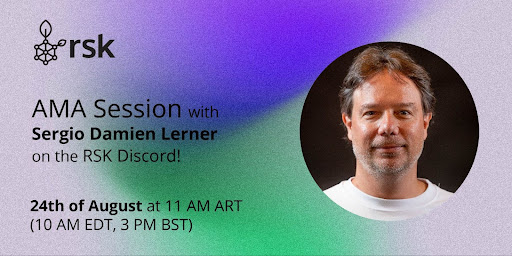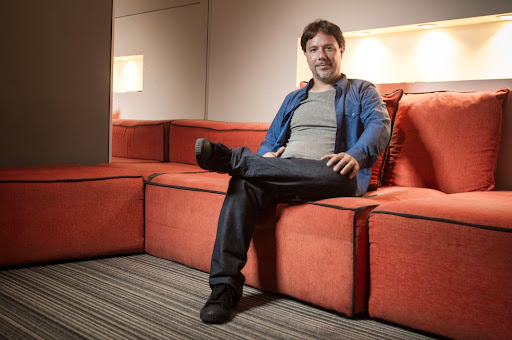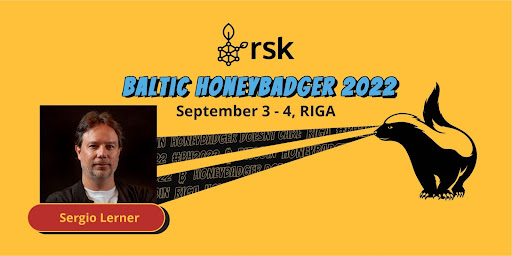Recap of AMA Session with Sergio Damien Lerner, RSK Co-founder

IOV Labs Chief Scientist & Rootstock Co-founder Sergio Demian Lerner took part in an AMA session on the 24th Aug 2022 on Rootstock’s Discord #AMA Channel. The Session was hosted by Anthony Sanches, IOV Labs Community Manager.

Thanks for tuning in to today’s AMA with IOV Labs Chief Scientist & Rootstock co-founder Sergio Demian Lerner! Well, without further ado, let’s get started!
Sergio, the first question from the community is: where do you see RSK in the next 5 years?
My vision for RSK in five years is a network that serves millions of users doing Everyday DeFi. The RSK community is a bitcoiner community. Bitcoiners think about Bitcoin in the context of historical processes that can take decades, and so do I. This is the spirit of the rootstock community. Creating a new open financial system is not something that will happen overnight. People do not come to Rootstock to become rich fast. They are coming because Rootstock solves real problems, like savings, transacting, and remittances. RSK is a stable and secure platform for Everyday DeFi. The fact that Rootstock does not have a native speculative token ensures an apolitical and smooth evolution of the project to meet scalability and other technical milestones. Rootstockers will stay through the coming bear and bull market cycles.
But there are also challenges. Three battles lie ahead in the future of the rootstock community and are shared with the whole crypto community. The first is the battle against overregulation. The second is the battle for transaction privacy as a fundamental right. The third is the continued battle to maintain the current decentralized attributes of RSK and hopefully expand them with the pressure of scaling the network and the emergence of new incentives (such as MEV) that may benefit one community group at the expense of another. To summarize, the whole crypto ecosystem is going through a tumultuous time of regulatory uncertainty, but if the ecosystem can sustain certain fundamental pillars, like the uncensorability and immutability of code, I see a bright future for Rootstock, with millions of people, that are now underbanked, transacting on RSK every day.
“My vision for RSK in five years is a network that serves millions of users doing Everyday DeFi.”
That’s very interesting! Hopefully, the benefit comes to the larger portion of the community, but indeed! Sergio, what are the main challenges regarding the Powpeg and its approval by the BTC community?
The Powpeg is a multi-signature hash rate escrow implemented in HSMs held by a federation. You can shuffle the words of the previous sentence, and probably you can come up with another description of what a Powpeg is, but this one is really good.
There is nothing the Bitcoin community needs to approve about the Powpeg. When we co-designed Rootstock, we realized that we couldn’t wait for the bitcoin community to reach a consensus over what would be the best sidechain technology to soft-fork into Bitcoin. Rootstock was created during the block size wars so that we knew the community would consider any other change very patiently. So we built RSK to satisfy the immediate need for DeFi for Bitcoin. We also built the RSK bridge to enable migration to any of the sidechain technologies that were known at that time: all variants of hash rate escrows. To make sure the transition was possible, I created my hash rate escrow BIP that was implemented, and it is ready for a future Bitcoin soft-fork.
Therefore, the ball is on the Bitcoin side now: the Bitcoin community must discuss alternatives and come up with the best possible sidechain solution, even though this may take years. As time passes, there is a stronger belief that sidechains are an important part of the Bitcoin ecosystem, and the continuous growth of RSK proves it.
Ha! Love the way you defined it at the top! And while Rootstock comes from the need for DeFi on bitcoin, the community asks: what makes Rootstock sidechain the best technology for scaling DeFi to billions of people?
Without going into the details of specific technologies, I would like to highlight that the ecosystem is constantly evolving, and new ideas, papers, and code are created every month. Therefore, I’m more worried about how RSK is strategically positioned to absorb the best technologies rather than if RSK will implement danksharding or rollups next week. All blockchains could theoretically adopt the best new technologies, but obviously, not all of them do. I find reasons why some blockchains won’t evolve and reasons why some may fail to try to evolve.
Here is why some blockchains won’t evolve:
- Hard Constants
Bitcoin won’t evolve quickly, and for a good reason: as a store-of-value, it needs to mitigate any migration risks, and it needs to rely on proven technologies. It needs to guarantee consensus, decentralization, and that the network will survive several generations, so that wealth can be safely stored. Therefore, it needs to guarantee some hard constants are kept, like the deflationary nature of the money supply or the block size. Apart from the still doubtful impact of the planned subsidy reduction in the security budget, Bitcoin faces no life-threatening risk, so it does not need to evolve.
- Cost
Some blockchains have made design decisions that are almost technically irreversible. For example, changing the UTXO model into an account model and vice-versa implies redesigning most of the blockchain. It is cheaper and less risky to create a sidechain than to migrate the main chain. This is what happened between Binance Chain (UTXO-based) and Binance Smart Chain (account-based). It is also one of the reasons for the separation between Rootstock and Bitcoin.
- Decentralization Left Behind
Some blockchains have adopted irreversible political changes. Even if the community decides that there is an alternative technology that is superior for decentralization, it is too late, and it would require breaking compatibility with deployed contracts. For example, Bitcoin Cash or Solana cannot reduce their “block sizes” to become a minimalistic decentralized chain now because that would break all applications that assume a low transaction cost and unlimited block payloads. Ethereum is on the verge of leaving decentralization behind, as very few people run full nodes, and existent nodes may soon begin to censor transactions due to regulatory pressure.
- Team
To evolve, you need talented people to innovate, learn, and adapt new technologies to your blockchain. Not all blockchains have a team of researchers and core developers that can do the job.
- Politics
A Blockchain community may embrace new technologies, but at the expense of messing up with basic incentives, benefiting one group over others, such as users vs. holders (as EIP 1559 did on Ethereum), or wealthy investors versus users whose small savings are diluted (as Ethereum’s PoS-switch is doing). This may continue up to the point where the blockchain evolution is politicized, and a power struggle begins. I imagine this can continue with the community claiming for the formation of a governance body, which then becomes the new privileged elite, which triggers a coup, and so on. We’ve seen this story so many times in history. Ethereum can fall into this trap under the numerous planned network upgrades.
Now I’ll explain why Rootstock won’t probably need to face any of these problems. Related to the problem of hard constants, sidechains were created to ease experimentation and scale Bitcoin without breaking it. Therefore, the community expects a certain degree of change. Also, the RSK whitepaper establishes a series of stages the network could evolve, preparing the community for evolution. While there is certainly a need to keep RSK decentralized, there are no hard constants that the community is tied to.
Regarding the problem of change cost, RSK is incredibly well positioned for change because it already relies on certain efficient internal data structures, such as the Unitrie. The Unitrie is the unique data structure that holds all the RSK states, and it is very similar to what Ethereum is trying to achieve painfully over many future upgrades. The Unitrie is a binary tree (enabling efficient Merkle-based stateless clients), it unifies account and contract storage (enabling efficient light clients and fine-grained transaction execution parallelization), it allows trie node versioning and timestamping (enabling the activation of fine-grained storage rent), and holds the original trie keys (enabling trie introspection in the VM). More importantly, the Unitrie has been RSK’s main data structure since its genesis. Therefore, the cost of the planned changes is low compared to Ethereum.
Got to admit that this helps with many concerns that come up from time to time. Very eloquent and to the point.
Concerning the problem of lack of Decentralization, RSK has taken a conservative approach to growth, always considering decentralization first. For example, the block gas limit was kept at 6.8M gas, and a higher load will be managed by increasing the number of execution threads, each with the same cap of 6.8M gas, not by abusing the increase in the single-thread block gas limit.
Regarding a team, RSK has 10 full-time researchers working on protocol improvements and a similar team of great core developers. There are also contributors.
About the problem of Politicization, Rootstock is internally apolitical in nature. Because Rootstock can not interfere with Bitcoin’s monetary policy, Rootstock is in a unique position where it can advance technologically without stirring up power struggles. For years Rootstock has evolved without politics, and we think it will keep evolving that way.
To summarize, Rootstock is in an outstanding position to grow using the latest technologies.
What allows the Rootstock sidechain to be so secure?
A complex system’s security cannot be measured by a single metric. Security is the result of the combined strength of a series of components and their interactions. This article explains the security efforts the community makes for every component of RSK.
TL;DR; it is not only the hash rate that secures RSK. The hash rate is important because it protects the RSK network against the well-known 51% attack. But in any blockchain ecosystem, there are thousands of other less known attack vectors. It’s the security-focused mindset present in every developer, in the design of every process, every software component and every hardware, and the monitoring and operation of support services that participate in the network. We’ve built a community with a culture of putting security first, and I hope it stays that way. What secures RSK is its community.
Thanks for the article! A must-read for Rootstock enthusiasts. Indeed, it can feel a bit “minimalistic” to try and bring down an entire system to a single metric, with you on that! What about RSK TPS thresholds?
The current transaction throughput is approximately 11 TPS. This value is computed as the current block gas limit (6.8M gas) divided by the cost of an rBTC transfer (21K gas) and the current average block time. However, this is not the “threshold.” Rootstock can scale much more than 11 TPS in the base layer. The limit has not been raised because the supply of block space still outweighs the demand for more TPS.
While several ongoing efforts to scale RSK are happening across different technical teams, it’s important to note that the transaction rate can increase organically and effortlessly based on how the mining pools configure their RSK nodes: mining pools can increase the block gas limit, and they can reduce the block interval (from current 31 seconds to around 16 seconds).
Regarding the block gas limit, the RSK node currently can support blocks at least twice as big without impacting decentralization. This is due to the node efficiency in handling transaction processing, based on past innovations such as the Unitrie, which none of the other EVM-based blockchains has. The RSK transaction rate could increase 4X with configuration adjustments adopted by the majority of the miners.
Concerning new developments, RSK can reach a higher transaction rate by improving its layer 1 (the consensus protocol and the RSKj node) and using 2nd layer solutions, such as rollups and payment channel networks.
There are currently hundreds of RSKIPs (technical proposals) in the repository, many related to scalability, waiting for an in-depth analysis by the community or for core developers to implement them. Since this is a community decision, it’s impossible to predict precisely which proposals will be accepted and when. I will focus on a few that I consider the most relevant for scalability and the ones that have been most discussed, iterated, and battle-tested.
Parallel transaction processing has been one of the hottest scaling topics in the EVM ecosystem, and RSK is at the forefront of this innovation with RSKIP-144 (link). This proposal enables parallel transaction execution over multiple threads. The RSKIP has already been coded, and ongoing simulations show it can double RSK transaction processing capabilities without impacting synchronization time.
Another scalability proposal is Storage Rent – RSKIP-240 (link). Since it was mentioned in the RSK Whitepaper, it has wide community acceptance. It’s in an advanced stage of development, and I believe it will be part of one of the network upgrades to happen shortly. This proposal reduces the state working set and enables higher performance when transactions only affect the most active contracts and accounts, which can be fully cached in RAM.
Still another scalability proposal expected to be considered in the following network upgrade is Micropow. Micropow reduces block intervals to 5 seconds, shortening the confirmation latency and improving the user experience.
Many other proposals do not require hard forks but aim to improve the RSKj node efficiency, which in turn allows increasing the block gas limit without increasing the network processing load. This is the case with FlatDB. FlatDB is a new database engine developed by the R&D team at IOV Labs, and it is designed for the efficient storage of blockchain state. This new DB reduces I/O operations (IOP) when processing blocks, allowing the block gas limit to be raised. Implementing FlatDB does not require a consensus change but only a new RSKj release. Combining these proposals, RSK could scale 10X up to 110 TPS.
On the 2nd layer, the RSK community is porting Ethereum’s rollups to RSK. Rollups enable approximately 100x scalability, lowering transaction costs 10x.

Sergio Demian Lerner, IOVLabs Chief Scientist & Rootstock Co-founder
Moving a bit over from Rootstock as a network. Are you thinking of giving $RIF more use cases?
IOV Labs constantly contributes to the RIF Ecosystem. The three main ongoing projects are:
- RIF Relay: A meta-transaction layer to enable paying all transactions in stablecoins or RIF.
- RIF Aggregation: A ZK-rollup on top of RSK to scale RSK transaction processing and reduce transaction costs even more.
- RNS: The RSK Name Service.
About the RIF projects, RNS is the one I have the most experience with. A bit of a change in a subject, but: Can you share any news about Lumino?
IOV Labs is currently not contributing to improving the Lumuno network because that team is focused on Aggregation, which provides scaling capabilities that compare to Lumino’s, but Aggregation is better suited for financial inclusion.
Makes sense. Now onto a bit of controversy, a community popular: what are your thoughts about the recent news on Tornado Cash?
This is a very disturbing event with rippling effects on all privacy-oriented chains and smart-contract platforms. The censorship of a contract shows how easy it is for a large nation-state to target an individual EVM dApp and create chaos, even without attacking the underlying consensus. However, I anticipated this exact situation in 2013 when I wrote an article about how difficult the coexistence of financial privacy is provided by cryptocurrencies and the legacy financial system. Either the crypto community helps the regulators understand how to address the challenges of these new technologies, or the smart-contract and privacy-oriented chains will have a hard time adapting to the mess the current regulations and sanctions are creating. Code should be protected as free speech, and privacy-preserving technologies should be embraced, not censored.
The RSK community is in a better position than Ethereum to fight against censorship for several reasons. First, the most used stablecoin in RSK is DoC, which is collateralized by rBTC on RSK. In contrast, the most used stablecoin in Ethereum is USDC which is collateralized by a company subject to US regulations. In the case of a fork (such as The Merge), BitGo and the other 2 parties that govern the USDC token will de-facto decide which of the Ethereum forks is the real one because in the other, all DeFi debs will be liquidated, and all liquidity pools get drained. Mining can also resist regulation pressure, and pools can dissolve and reorganize in any part of the world without much downtime. Powpeg pegnatories could also be subject to regulatory pressure, but being part of the Powpeg only requires keeping a PowHSM online and connected to the network, which is something that can easily be carried out by a single individual in any remote part of the world with Satellite Internet. Therefore, the RSK community can perform a UAHF to oppose any imposed network fork, and this gives the RSK community enormous power.
“The RSK community is in a better position than Ethereum to fight against censorship for several reasons.”
Regarding technical matters, it seems that the UTXO model adopted by Bitcoin could be a defense against broad AML blacklisting because received coins are automatically segregated. If the receiver of an unsolicited payment does not spend that specific UTXO, AML-oracles can keep other UTXOs reusing the same address unblocked. On the contrary, the account model proposed by Ethereum and RSK does not allow the segregation of coins natively transferred. If regulatory bodies start blacklisting whatever account is touched by funds coming from other blacklisted accounts, then all users will be hurt. Enabling segregation would require complex consensus changes. The ERC-20 token standard is also incapable of stopping or segregating unsolicited payments, so a new standard would need to emerge. To summarize, this topic deserves the full attention of the crypto community.
And to some extent, it does have the attention of the full crypto community. This next question is mine! As a VR + Crypto enthusiast, I wanted to know: What are your opinions on the metaverse? Do you think the metaverse like Mark Zuckerberg imagines holds any real-world application as it is?
Not like M.S. imagine it! A company-owned economy as envisioned by Meta is much closer to a dystopian Orwellian world than to the cypherpunk dream. I think a metaverse like Decentraland can be a source of new use cases for cryptocurrency, tokens, NFTs, and in-game virtual goods. But the key to success is interoperability: a virtual good that is limited to a single platform is much less valuable than a virtual good that can move freely between games and markets. And a platform must be neutral to get enough traction to support the world’s user-defined tokens. Therefore it is more probable that such a global metaverse platform emerges as a Bitcoin sidechain than as a natively tokenized protocol.
When talking about RSK to people, I usually get “it has been around for years and hasn’t gotten anywhere” while I have my answers to this. I am curious about what you think is the best way to answer this statement.
The short answer to this question is “you.” Each community member is responsible for taking the message further, participating in improving Rootstock, and keeping active Rootstock ideals of bitcoin and decentralization.
The long answer is that when we created Rootstock we knew growth would be slower than pre-mined chains because we wouldn’t have coins to airdrop or money to pay for marketing as EOS did. We didn’t set incentives for gamblers to join our community, and I think it was good. The only way Rootstock can grow is by satisfying real use cases. And the fact that it grew so much by doing so is enormously rewarding.
Is it possible to create a bridge between RSK and Liquid networks?
Any two blockchains can be bridged by a federated bridge. The interesting question is if these two chains can be connected by a decentralized bridge. XCLAIM can do it, but at a high capital cost. So even better would be that the decentralized bridge is capital efficient and creates fungible wrapped tokens. That leaves XCLAIM out (and its variant with periodic time-locks).
What is left is either a two-way SPV bridge (that could be made more efficient with FlyClient proofs) or a bridge that uses proof of computation integrity (i.e., STARKs or SNARKs). For evaluating any of these proofs, you need certain flexibility in the scripting language (not necessarily Turing-completeness). RSK can do it, but Liquid does not provide that flexibility yet. There is a new scripting language called Simplicity created by Blockstream, but AFAIK is not yet active in Liquid.
What you could do is create an HSM-enforced bridge, such as the RSK Powpeg, that connects RSK with Bitcoin. The PowHSM could be easily adapted to bridge RSK with Liquid, but the Bridge contract in RSK is a precompiled contract, and it currently supports a single blockchain: Bitcoin.
Anyway, if there are real use cases that can benefit people, the community can do it!
Going a bit in the vein of the role of the community in the RSK network: are there plans to make it easy to run an RSK node without coding background? Like on an umbrella?
You don’t need the coding background to run your own RSK node, but if you want a third party to run a node for you, then you can choose from GetBlock, NOWnodes, or Extrimian.
Indeed! NOWnodes was recently on the RSK Ecosystem update, and they gave a very compelling presentation.
Another question from the Rootstock community: Is it possible to have faster block times in RSK to improve the user experience? Also, are there any other scaling plans like ZK-Rollups being worked on?
At the IOV Labs R&I team, we designed an extension to the RSK consensus protocol called Micropow that enables 5-second blocks. The protocol elects a leader every 30 seconds on average, and the leader creates several blocks in a row. We may publish a paper about it by Q1 2023, together with articles and code.
The scaling plan we propose to the RSK community is based on three parallel research initiatives: improving the node resource consumption efficiency, better-supporting rollups, and supporting a variant of danksharding that works with our consensus protocol. The first two are active now, and the third will be activated concurrently with Ethereum.
About improving the RSK node, I copy here a recap of the existent proposals and works that are active:
- Reduced Block propagation time/synchronization time
- Parallel Transaction Processing (RSKIP-144 Proposal)
- FlatDB storage engine in the works (custom ultra-fast DB)
- Reduced Computation
- Light client implementation
- Faster light client synchronization with FlyClient proofs.
- Reduced Historic Blockchain Storage
- Ephemeral blockchain: Proposal to prune all old blocks while keeping best-chain objectivity (RSKIP-215)
- Reduced State Storage
- Storage-rent (RSKIP-240)
- FlatDB storage
- Reduced network bandwidth
- Faster transfers with COBLO (RSKIP-62)
- Faster synchronization using FlyClient proofs
- Reduced Latency/transaction settlement time
- Micropow proposal reduces average block latency to 5 seconds and provides a slashable penalty on equivocation, leading to almost immediate finality.
- External Hashrate Confirmation (RSKIP-178)
Which protocol/Dapp is your favorite on RSK?
My favorite core-level protocol is the RSK Bridge itself, which has an embedded SPV wallet and blockchain SPV client. The next is Flyover, which lets you peg in and out to/from RSK with just one Bitcoin confirmation in a trust-minimized way. Next is RIF Relay, which enables transacting with stablecoins even if you don’t have rBTC in your wallet to pay for gas.
“Security is the result of the combined strength of a series of components and their interactions.”
About DeFi, I’m a bitcoiner, and I’m very risk averse. Therefore I follow the advances on DeFi financial products, but I do not participate actively in trading, arbitrage, lending, or borrowing. My favorite Dapp is Money on Chain, which created the stablecoin backed up by Bitcoin collateral. I understand that the financial excluded that join RSK cannot be exposed immediately to the volatility of Bitcoin, and they need fiat-pegged coins to transact and eventually save for the short term. Using stablecoins allows them to familiarize themselves with the technology and eventually buy Bitcoin.
Do you think that projects like MoC and Tropykus should have a governance token?
Each of these projects has its independent communities. That’s a decision they need to take. But I think governance tokens are a super powerful tool. I love protocols that do not need to be governed, and that means they are 100% decentralized. But if you need to be able to perform certain changes, then let them be democratic.

Save the date and see Sergio Demian Lerner’s presentation to learn more about Rootstock and DeFi on Bitcoin at the Baltic Honey Badger Conference, on September 04th at 4:35 PM EEST (9:35 AM EDT).
For more information, please see: https://baltichoneybadger.com/agenda
Follow Sergio Demian Lerner on Twitter: https://twitter.com/SDLerner




